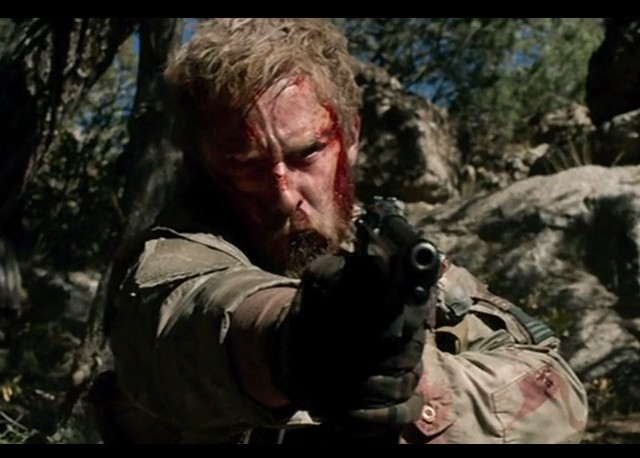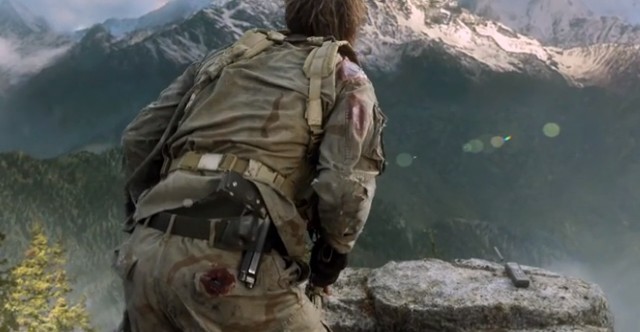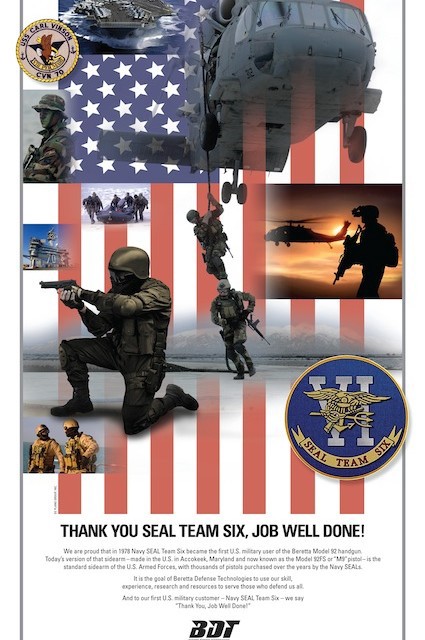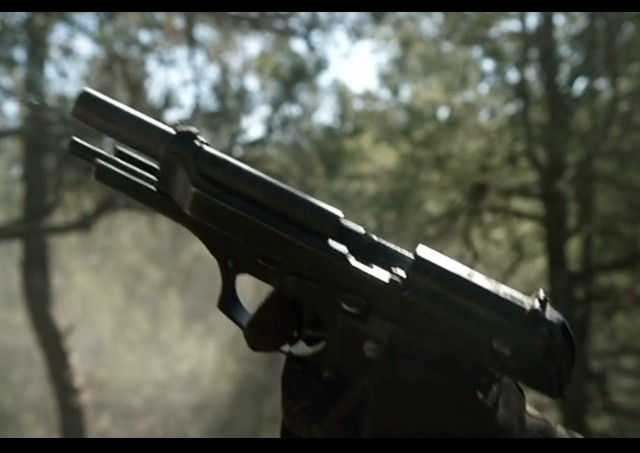How Far Beretta Will Go To Make You Love Guns
by Abe Sauer

“We checked all the Hollywood crap at the door.”
— Mark Wahlberg, speaking about the making of Lone Survivor, in USA Today, December 22, 2013.
Even though it just opened on Christmas, Lone Survivor has made more money in the U.S. than Oscar-nominated thriller Captain Phillips, which opened back in October — and also stars Navy SEALs. Lone Survivor also beat big 2013 movies like The Hangover 3, Pacific Rim, Oblivion, and Elysium.
Lone Survivor has already made half as much in the U.S. as 1998’s Saving Private Ryan, the epic war film to which critics — and its marketing material — favorably compare it. It’s already beaten the war film it most resembles — Black Hawk Down — and its recent SEALs film peers — Act of Valor and Zero Dark Thirty. It’s creeping up on Platoon.
In Texas, at least one theatre canceled all of its other films in order to put, on all of its screens, the true story of 2005’s Operation Red Wings, in which three of a four-man SEAL team were killed, along with all aboard a rescue helicopter. It has a 90 percent audience “high” rating on Rotten Tomatoes and is now without a doubt by far the most popular film ever made about the the Naval Special Warfare Command’s Sea, Air and Land teams, which we know as the Navy SEALs.
But despite Wahlberg’s claim about “checking” all the Hollywood stuff, Lone Survivor is a terrific vehicle for product placement. One firearms maker, with a storied history of trying to attach its name to the Navy’s legendary teams, certainly saw the retelling of the last hours of three SEALs’ lives and thought: “What a great marketing opportunity.”
Beretta’s M9 pistol appeared prominently during one of Lone Survivor’s most heart-wrenching scenes: A SEAL more or less sacrifices himself for a teammate. The gun’s appearance immediately set off online discussions by those in-the-know.
In his last moments, the SEAL — portrayed by actor Ben Foster — draws a Beretta M9 and hopelessly tries to defend himself against countless Taliban fighters. While the Beretta M9 is the officially issued sidearm of the U.S. armed forces, generally SEALs carry SIG Sauer pistols. Numerous pictures taken of the four real SEALs on duty prior to that mission show the men carrying SIG Sauers. The M9 is particularly disfavored by SEALs for a number of reasons.
“Brand-in Entertainment successfully integrates Beretta into Lone Survivor” read the announcement from “the premier brand integration firm in Los Angeles.” Lone Survivor’s cast of SEALs carried Beretta M9s because Beretta paid for it. But why?
“If Beretta paid the producers of Lone Survivor to put their weapons in the film, it was to impress wannabe SEALs. It had nothing to do with influencing actual SEALs or other SOF” — soldier of fortune — “types,” a former SEAL, and father of a SEAL, told me when asked about Beretta’s role in the film. (He asked that he not be named.) “The Beretta pistol 92FS or M9 has never been a favorite of the SEALs,” he said.
In Lone Survivor, the original book by Marcus Luttrell about the Red Wings mission, the SIG Sauer is mentioned twice. In No Easy Day, the book account of the mission that killed Osama bin Laden, the Sig P226 is also identified. The film based on that book, Zero Dark Thirty, also made a distinct point to use the SIG Sauer on-screen. In his hit book American Sniper, the late SEAL Chris Kyle noted that he carried a Springfield 1911 model until switching to the SIG Sauer P220.
While all of these top-level endorsements are a rightful point of pride for SIG Sauer, they’re also a stick in the eye for Beretta.

In 1985, the U.S. military switched its official sidearm from the decades-old and iconic 1911 to the Beretta M9. It was a landslide for Beretta: more than 321,000 guns and tens of millions of dollars in guaranteed orders. Being able to market itself as the official sidearm of our very discerning and globally preeminent fighting force meant even more profits in the civilian market. Beretta’s plan was plainly outlined in a 1993 Baltimore Sun interview with Robert Bonaventure, then CEO of Beretta USA. Bonaventure explained that Beretta made it a mission to win the military contract and leverage it to make Beretta a household name — a name that would get it into the law enforcement market and, eventually, the everyday gun buyer. To win the contract, Beretta’s bid charged the military a nearly break-even price of around $225 a pistol. The price tag on the gun for civilian customers who wanted the “same” pistol used by the military? About $625.
But Beretta’s grand plan jammed. Just a few years after its contract award, Naval Special Warfare units started reporting slide failures with the M9, resulting in several severe facial injuries. (Today, the myth “You’re not a SEAL until you taste Italian steel” refers to this method of Beretta testing — though, it seems the motto is more urban myth than truth.)
Initially, Beretta blamed the Navy, saying its men were firing improper rounds. Investigations found the fault was with Beretta, which had used substandard steel from Italy. Guns were rejected; Beretta appealed. A new request for bids was issued but which itself brought protest from other makers like Smith & Wesson, claiming Beretta was being treated too leniently. Government Accountability Office records from 1988 and 1989 show numerous filed protests and dismissals. Beretta ultimately moved production to the U.S., was awarded a new contract and resolved its problem.
But Beretta’s M9 rollout was the Obamacare of official military sidearms.
With its problems finally worked out, the M9 went on to have a successful operational life as America’s military sidearm. In 2012, its contract was re-upped. But both performance reasons and Beretta’s initial scapegoating of Navy operators left a bitter taste in SEALs’ mouths (pun intended). Because SEALs can carry any firearm they see fit, in 1989 SEALs dropped the Beretta that some of them had carried since 1979 and instead began carrying the SIG Sauer. They never went back.
Within the firearms trade, “tactical” has become a hot sector. The tacticalization of the firearms market can also be seen in examples like the increasing civilian popularity of military-birthed rifles like AR-15s, those guns’ highly customizable rail systems, Barrett Firearm’s .50 cal “sniper” rifles, “bull-pup” tactical shotguns, holographic sights and muzzle add-ons like suppressors (silencers) and MOLLE gear. So, so much MOLLE gear.
1. One linguistic example of how the more militarized domestic police forces are seeing themselves more and more like SEALs is how these law enforcement and SWAT units refer to themselves as “operators,” a term historically reserved for only top-tier military personnel. Another is the blurring divide between military special operators like SEALs and private contractors who fill the many cracks in the “War on Terror.” A perfect case in point is the new book Civilian Warriors: The Inside Story of Blackwater and the Unsung Heroes of the War on Terror… by Blackwater founder, and former SEAL, Erik Prince.
2. According to a Spy magazine investigation (“Steven Seagal- Man Of Dishonor”; July/August 1993), Steven Seagal — who portrayed a Navy SEAL at least twice onscreen — used to brag to people that he had been a Navy SEAL.
This boom in “tactical” has been fed in part by an increased militarization of America’s police forces that has resulted in local sheriff’s deputies conducting day-to-day law enforcement while so geared up that they are nearly impossible to distinguish from, say, soldiers involved in an Afghanistan operation like Red Wings.1 It’s a marketplace where terms like “operator” and “downrange” are now used by consumers who are not, and will never be, either. The poster children of this phenomenon are the police chief of the Chicago suburb of Waukegan, who lied on his resume about attending the BUD/S training that qualifies Navy SEALs and one Mr. Steven Seagal.2 (It’s also no surprise that even though “tactically geared” police forces may look more and more like SEALs, they are far more blundering and dangerous; the Cato Institute’s interactive map of Botched Paramilitary Police Raids is a fright to behold.)
Then came a rush of websites and blogs — like Tactical-Life.com, TacticalGear.com, “Silent Professionals” and TacticalFanboy.com — which all inventory and detail tactical products. There is nothing more “tactical” than a SEAL. The SEALs are now a booming business — Florida’s Navy SEAL Museum, founded in 1985, has seen attendance spike from just over 25,000 in 2008 to well past 60,000 in 2011, the year SEAL Team Six killed bin Laden. A product that is genuinely linked to the Navy Seals can see its sales fortunes made.
Why wouldn’t brands latch on to Hollywood SEALs for marketing? But those looking to team with real-life high-profile ex-Seals do not have many options. First, retired SEALs are generally loathe to come across as shills. There area also just not that many well-known SEALs out there. Resco wristwatches partnered with former Navy SEAL sniper and author of The Red Circle Brandon Webb. And before he was killed in Texas in 2012, ex-SEAL sniper and author of American Sniper Chris Kyle was part of Kryptek Outdoor Group’s pro staff. SOG Knives has enlisted the spokesmanship of Rorke Denver, one of the “real life” SEAL stars of 2012’s Act of Valor and author of Damn Few: Making the Modern SEAL Warrior.
Other former SEALs, like Jesse Ventura (BUD/S class 58, conspiracy loon, hurried bleeder) and Ben Smith (Tea Party birther who accused Obama of collaborating with Islamic fundamentalists), are not exactly commercially attractive. (Though, it must be said that SEALs have become very politically attractive. For example, Smith is a popular Tea Party event and National 912 PAC spokesman, and Marcus Luttrell has appeared on behalf of the NRA and endorsed Texas Governor Rick Perry for president.)
Lacking a genuine Navy SEAL endorsement is by no means a roadblock to leveraging a SEAL association. California-based weapons accessory manufacturers MFI offer a “MFI M4 Navy Seal Marked Style Fake Silencer” that will make an AR15-style rifle look like the short barrel of the M4 carried by many SEALs (including those in Lone Survivor). MFI’s “dummy can” shroud is laser-engraved with the SEAL eagle emblem. Gun maker Ruger recently released a SR1911 Navy Seal Foundation .45 ACP pistol. The limited edition of 500 pistols sold for around $1,000 each; Ruger donated $50,000 of that to the Navy SEAL Foundation. Even Airsoft gun sellers on Amazon list their replicas as “Navy SEAL Assault Rifle.” Sunglasses brand Gatorz was also quick to point out its “tactical” appearance in Lone Survivor. Gunbroker.com is filled with products labeled “SEALs.” And in a 2012 Faircount Media special publication Navy SEALs 50: Commemorating the 50th Anniversary of the Establishment of the U.S. Navy SEALs, Universal Pictures took out a full page ad saluting the anniversary and the SEALs on behalf of the entire cast and crew of its 2012 film Battleship. Peter Berg directed that film before Lone Survivor; Universal bought the rights for Lone Survivor in 2007.
Meanwhile, Beretta, barring a real life association with the SEALs, is hoping to reach armchair operators by paying to put itself in the hands of Hollywood actors pretending to be real-life SEALs. Lone Survivor was not their first shot.

In the immediate aftermath of the 2011 killing of Osama bin Laden, Beretta rushed out an advertisement congratulating SEAL Team Six on a “job well done!” The ad featured non-SEAL operators wielding the Beretta M9. The ad’s accompanying commentary:
“Beretta shares a close association with the U.S military, particularly Navy SEAL Team Six, having intimately collaborated with members of the team during the initial design phase of what would become the venerable M9, the official sidearm of the U.S. Armed Forces. The SEALS recognized Beretta’s skill, experience, research capabilities and resources, and it is those same benchmarks that Beretta Defense Technologies continues to utilize today as they strive to serve those who defend freedom around the world.”
A person reading that would almost think SEALs carry Berettas. That’s surely Beretta’s hope. And if that wasn’t enough, Beretta’s ad had the balls to credit with collaboration the same group that it tried to blame during its failures in the late 1980s.
It’s definitely worth noting that some SEALs see the whole thing as a tempest in a teapot. Don Shipley, the wildly charismatic former SEAL behind Extreme SEAL Experience — and host of an entertaining and necessary weekly Youtube series that publicly outs and embarrasses fake Navy SEALs — told me it’s no big deal. Shipley, who considers himself a friend of Luttrell’s, said he understands that Hollywood is going to be Hollywood. He said it’s only the gun obsessives who key in on the detail.
Beretta is well aware of the power of film over reality. In his 1993 interview, Beretta’s Robert Bonaventure pointed to successes the gun maker had in the films Lethal Weapon and Die Hard. More recently, Beretta has used Twitter to point out its product placements, like in Mr. and Mrs. Smith and “The Walking Dead.” (Ironically enough, Berettas were also the sidearm of choice in the silly, Charlie Sheen-helmed 1990 film Navy Seals.) Luttrell is certainly aware of the power of film. In an interview with Fox News, the author said, “No matter how many times I get up and tell (my story), or how many people read the book, it’s nothing compared to how many people will watch this film.”
Having an awesome dinner w/ video crew taking about Lone Survivor.
— BERETTA (@Beretta_USA) June 8, 2013
Then there is the fact that Beretta has cozied up to Lutrell since he retired from carrying a SIG Sauer as an active SEAL. Going back to 2009, Beretta has sponsored Luttrell in its Outdoor network show “Wild and Raw,” a hunting series in which Luttrell and others “put the line up of Beretta guns and gear to the test.” Also, Beretta donated $5,000 to Lutrell’s Lone Survivor Foundation. (Under Armour — which was also, dubiously, all over in the film — is a Lone Survivor Foundation supporter and last year partnered with the organization for an elaborate Lone Survivor Texas Tech college football uniform.)
Beretta did not reply to requests for comment. Despite a willingness to boast online about “successfully integrating Beretta into Lone Survivor,” when reached for comment, Brand-in Entertainment refused to answer any of my questions. Luttrell’s representatives told me he was only a consultant and suggested I call director Peter Berg’s production company. (In addition to appearing in two uncredited roles in the final film, Luttrell used numerous interviews to talk about his close involvement in the film.)
In the meantime, Lone Survivor’s huge box office has Hollywood on the hunt for similar tales of real-life SEAL valor. The late Chris Kyle’s life story is already in production with Clint Eastwood and Bradley Cooper. Fearless, the story of the late SEAL Adam Brown, has also been mentioned. Probably not on the radar is the recent story of Brett Jones, the SEAL whose operational career was ended when the Navy discovered he is gay. Plenty of new projects for Beretta’s Hollywood representatives to be on the lookout for.

In the end, there is one real-world incident involving a SEAL endorsing a Beretta that might interest the gun maker. In a senselessly dreadful event in 2009, two men shot Marcus Luttrell’s dog DASY. (The name was an acronym for his team members.) While pursuing the shooters at high speed, Luttrell called 9–1–1, informing the operator he was armed and giving chase.
“What kind of gun do you have?” asked 911.
“I got two 9 millimeter Berettas,” Luttrell said.
Endnote: The vast discrepancies between what happened during Operation Red Wings, the events Marcus Lutrell described in his book, and the fantasy finally portrayed in Mark Wahlberg and Peter Berg’s film has been vivisected in excruciating detail by the excellent blog On Violence. It’s a must-read to understand “anti-military Hollywood” posturing and how a tragic battle during our nation’s most complicated and longest war is reduced to a Department of Defense recruiting film. And, of course, a chance for a U.S. gun maker to market some pistols.
Abe Sauer’s latest book is the north woods parody “Goodnight Loon.” He is also the author of the book “How to be: North Dakota.” Email him at abesauer @ gmail.com.
